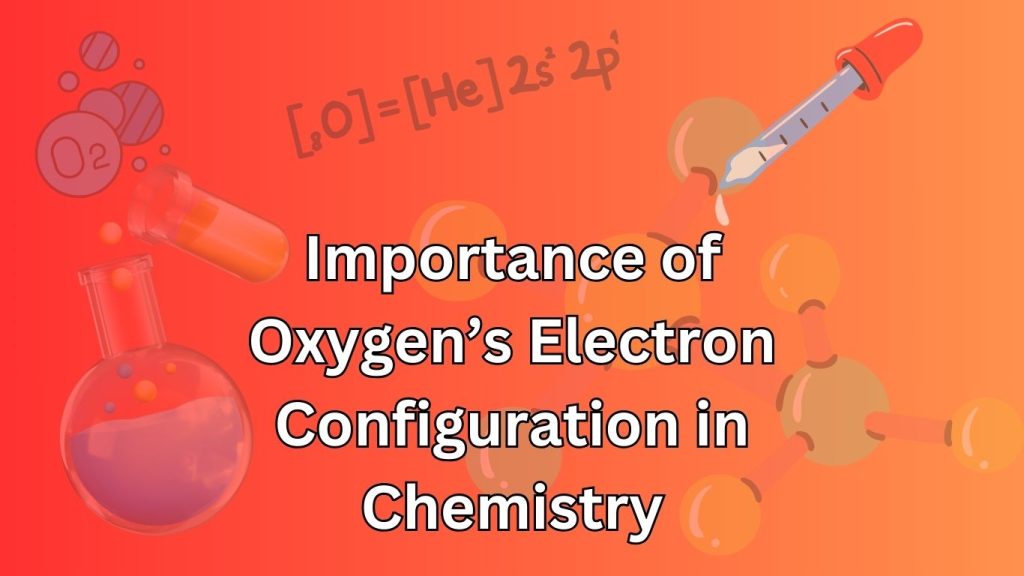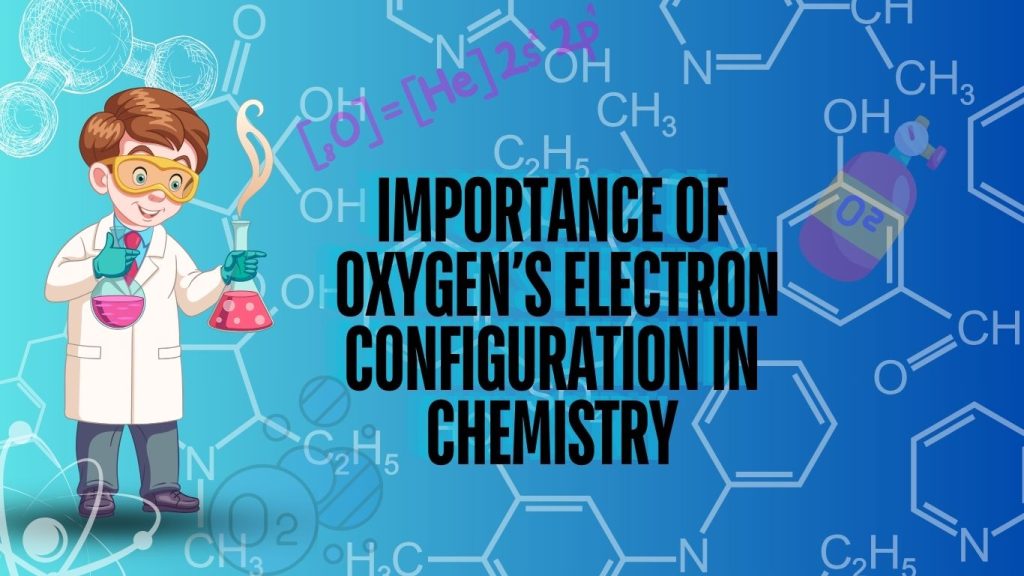The importance of Oxygen’s electron configuration in chemistry is very crucial. It determines how oxygen’s reactivity.
Oxygen’s electron configuration is very important in chemistry. Oxygen, with an atomic number of 8, plays a vital role in chemistry due to its electron configuration. This configuration, 1s² 2s² 2p⁴, indicates that oxygen has six valence electrons. These valence electrons enable oxygen to form stable bonds, particularly in creating water and organic compounds.
Oxygen’s high electronegativity also makes it a key player in redox reactions. Understanding its electron configuration helps explain its role in combustion, respiration, and various industrial processes. Chemists rely on this knowledge to predict reaction behaviors and design chemical syntheses. Consequently, oxygen’s electron configuration is foundational in both theoretical and applied chemistry.

Oxygen In The Periodic Table
Oxygen is in Group 16 of the periodic table. It is the 8th element and has 8 electrons. Oxygen is a non-metal and highly reactive. It forms compounds with almost all elements. Oxygen is essential for life on Earth.
| Element | Group | Reactivity |
|---|---|---|
| Oxygen | 16 | High |
| Nitrogen | 15 | Moderate |
| Carbon | 14 | Low |
Electron Configuration Basics
Atoms are made of protons, neutrons, and electrons. Protons and neutrons are in the nucleus. Electrons move around the nucleus.
Electrons are in layers called shells. Each shell has subshells labeled s, p, d, and f. Oxygen has electrons in the first and second shells.
Oxygen’s Electron Configuration
Oxygen’s electron configuration is 1s² 2s² 2p⁴. This means it has two electrons in the first shell, four electrons in the second shell, and two more electrons in the second shell’s p-orbital. The notation helps scientists understand its chemical behavior. Each electron first fills the lowest energy level, a rule called the Aufbau principle.
Electrons in oxygen occupy different energy levels. The first level is closest to the nucleus and holds two electrons. The second level can hold up to eight electrons. Oxygen has six valence electrons at this level, which are important for chemical reactions.
Chemical Bonding
Oxygen has six electrons in its outer shell and needs two more to be stable by sharing electrons with other atoms, oxygen forms covalent bonds. This sharing of electrons makes molecules like water. Water has two hydrogen atoms bonded to one oxygen atom. This type of bond is very strong and holds the atoms together tightly.
Oxygen can also gain two electrons from other atoms. This makes oxygen a negative ion. When oxygen gains electrons from metals, it forms ionic bonds. Sodium oxide is an example of an ionic bond. Sodium gives electrons to oxygen. This transfer makes a strong bond. Ionic bonds create compounds with high melting points.
Role In Molecular Geometry
Oxygen’s electron configuration affects bond angles. This configuration helps to predict the shape of molecules. For example, in water (H2O), the bond angle is about 104.5 degrees. This angle is not 180 degrees because of the lone pairs on oxygen. These lone pairs push the hydrogen atoms closer together. The bond angle is a key part of molecular geometry.
Molecular shapes depend on oxygen’s electron configuration. In water, oxygen has two lone pairs. These lone pairs affect the shape, making it bent. Other molecules with oxygen, like carbon dioxide (CO2), have a different shape. CO2 is linear because it has no lone pairs on the central oxygen. Understanding these shapes helps chemists predict molecule behavior.
Reactivity And Oxidation States
Oxygen forms many compounds. Water is a common one. Another is carbon dioxide. These compounds are essential for life. Oxygen often bonds with hydrogen and carbon. These bonds are strong and stable. Oxygen is very reactive. This makes it important in many reactions.
Oxygen usually has an oxidation number of -2, which means it gains two electrons. In peroxides, the oxidation number is -1. In superoxides, it is -1/2. These numbers are important in redox reactions, help balance chemical equations, and are key to understanding chemistry.
Oxygen In Biological Systems
Oxygen’s electron configuration makes it highly reactive and essential for cellular respiration. Its ability to form stable bonds is crucial in energy production within biological systems.
Cellular Respiration
Oxygen is crucial for cellular respiration. Cells use oxygen to make energy, which occurs in the mitochondria. Oxygen helps to break down glucose into ATP, which is the energy cells need to work. Without oxygen, cells cannot produce enough energy.
Photosynthesis
Plants need oxygen for photosynthesis, which takes place in the chloroplasts. Plants use sunlight to make food, turning carbon dioxide and water into glucose and oxygen. Oxygen is released into the air, providing oxygen for all living things.
Learn more about Oxygen Electron Configuration in the main guide
Industrial Applications
Oxygen is produced in large amounts. Factories use different methods to produce it. The air-separation process is common. This method cools air to very low temperatures. Oxygen turns into a liquid and then is separated from other gases.
Another method is pressure-swing adsorption, which uses special materials to trap oxygen from the air and release it as pure oxygen. Factories also use electrolysis, which splits water into oxygen and hydrogen.
Oxygen has many uses in industry. It helps make steel and other metals; factories use oxygen to cut and weld metals. Oxygen is also important in the chemical industry, where it helps make chemicals like nitric acid and hydrogen peroxide.
In the medical field, oxygen is crucial. Hospitals use it for patients who have trouble breathing. Oxygen is also used in space travel. Astronauts need it to breathe in space. It is stored in tanks on spacecraft.
Frequently Asked Questions
What Is Oxygen’s Electron Configuration?
Oxygen’s electron configuration is 1s² 2s² 2p⁴. It shows the arrangement of electrons in orbitals.
Why Is Oxygen’s Electron Configuration Important?
It determines oxygen’s chemical properties and reactivity. It explains bonding behavior and interaction with other elements.
How Does Oxygen’s Electron Configuration Affect Bonding?
Oxygen’s electron configuration allows it to form two bonds. This is due to its six valence electrons.
What Role Does Oxygen’s Electron Configuration Play In Reactions?
It helps predict how oxygen will react with other elements. This is crucial in chemical reactions.
Conclusion
Understanding oxygen’s electron configuration is crucial for mastering chemistry concepts. It plays a key role in reactions, and this knowledge aids in predicting chemical behavior and bonding patterns. Grasping these basics enhances comprehension of complex compounds and their interactions. Embrace this fundamental concept to excel in chemistry studies and applications.
